Coloring Plastics, Transforming Industries: The Masterbatch Effect

The global masterbatch market is a crucial segment of the plastics industry, providing essential color and additive solutions to enhance the performance and aesthetics of plastic products. Masterbatch is a concentrated mixture of pigments and additives used in the production of plastic items, ranging from packaging materials to automotive components. With advancements in polymer science and the rising demand for high-performance plastics across various industries, the masterbatch market is experiencing significant growth.
Market Dynamics
Drivers:
Technological Advancements: Innovations in masterbatch technology, including improved dispersion techniques and enhanced performance additives, are driving market growth. These advancements enable better color consistency, durability, and functionality of plastics.
Growing Demand from End-Use Industries: The increasing demand for plastic products in sectors such as automotive, packaging, and consumer goods is boosting the masterbatch market. The need for aesthetic appeal and functional attributes in plastics fuels the demand for high-quality masterbatch solutions.
Challenges:
Volatile Raw Material Prices: The prices of key raw materials used in masterbatch production, such as pigments and polymers, can be highly volatile. This volatility affects production costs and pricing stability for masterbatch producers.
Environmental Concerns: The plastics industry faces growing scrutiny over environmental impacts, leading to increased regulatory pressure. Masterbatch producers are challenged to develop sustainable products and reduce the environmental footprint of their offerings.
Opportunities:
Sustainable and Eco-Friendly Solutions: There is a rising demand for biodegradable and recyclable masterbatch products as industries seek to align with sustainability goals. Opportunities exist for companies to innovate and offer eco-friendly masterbatch solutions.
Expansion in Emerging Markets: The rapid industrialization and urbanization in emerging economies present significant growth opportunities for the masterbatch market. Companies can expand their presence in these regions to capture new market shares.
Regional Analysis
North America: North America holds a significant share of the masterbatch market, driven by advanced industrial infrastructure and high demand from the automotive and packaging industries. The U.S. and Canada are key contributors to the market growth in this region.
Europe: Europe is a prominent market for masterbatch, with strong demand from the automotive, packaging, and consumer goods sectors. The region is also focusing on sustainability, influencing the development of eco-friendly masterbatch solutions.
Asia-Pacific: The Asia-Pacific region is expected to witness the fastest growth in the masterbatch market due to rapid industrialization, increasing manufacturing activities, and rising consumer demand. China and India are major contributors to the market expansion in this region.
Latin America: The market in Latin America is growing, driven by increasing industrial activities and the demand for plastic products. Brazil and Mexico are key players in the region.
Middle East & Africa: The masterbatch market in the Middle East & Africa is expanding due to infrastructural development and rising demand for plastic products. However, the market remains relatively small compared to other regions.
Sample pages of Report: https://www.infiniumglobalresearch.com/form/199?name=Sample
Market Segmentation
By Type:
Color Masterbatch: Used to provide various colors to plastics.
Additive Masterbatch: Includes functional additives such as UV stabilizers, flame retardants, and antistatic agents.
White Masterbatch: Provides whiteness and opacity to plastics.
By Application:
Packaging: Used in food and beverage, consumer goods, and industrial packaging.
Automotive: Applied in interior and exterior components.
Consumer Goods: Includes applications in household products and electronics.
Others: Includes applications in agriculture, construction, and textiles.
Competitive Landscape
Market Share: Large players in the masterbatch market, such as Clariant, BASF, and PolyOne, hold a substantial share of the market due to their extensive product portfolios and global reach. These companies leverage their scale and technological capabilities to maintain a competitive edge.
Price Control: Major players often influence pricing through their established supply chains and production efficiencies. However, competitive pricing pressures from smaller and mid-sized companies can impact price dynamics in the market.
Competition from Smaller Players: Smaller and mid-sized companies often challenge large players by offering specialized or customized masterbatch solutions, focusing on niche applications, and providing competitive pricing. While large companies dominate in terms of market share, smaller firms are increasingly carving out their own segments in the market.
Key Players: Notable companies in the masterbatch market include Clariant, BASF SE, PolyOne Corporation, A. Schulman, and Ampacet Corporation. These companies are known for their innovative products and extensive distribution networks.
Report Overview : https://www.infiniumglobalresearch.com/market-reports/global-masterbatch-market
Future Outlook
Does New Product Development Really Help Companies?
Yes, new product development is crucial for companies in the masterbatch market. Innovations in masterbatch formulations, such as the introduction of sustainable and high-performance products, help companies differentiate themselves and meet evolving customer demands. Continuous R&D and product development drive competitive advantage and market growth.
Do Sustainable Products Hold Strong Customers' Minds?
Yes, sustainable products are increasingly important to customers. The growing emphasis on environmental responsibility is driving demand for eco-friendly masterbatch solutions. Companies that focus on sustainability, such as offering biodegradable or recyclable masterbatch, are better positioned to attract environmentally conscious customers and align with global sustainability trends.
Conclusion
The masterbatch market is poised for significant growth, driven by advancements in technology, increasing demand from end-use industries, and a shift towards sustainable solutions. While large players dominate the market, smaller and mid-sized companies continue to innovate and challenge established players. The market's future will be shaped by continued product development and the growing emphasis on environmental sustainability, offering both challenges and opportunities for industry participants.